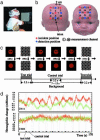Brain imaging in awake infants by near-infrared optical topography
- PMID: 12960368
- PMCID: PMC196871
- DOI: 10.1073/pnas.1932552100
Brain imaging in awake infants by near-infrared optical topography
Abstract
Studies of young infants are critical to understand perceptual, motor, and cognitive processing in humans. However, brain mechanisms involved are poorly understood, because the use of brain-imaging methods such as functional magnetic resonance imaging in awake infants is difficult. In the present study we show functional brain imaging of awake infants viewing visual stimuli by means of multichannel near-infrared spectroscopy, a technique that permits a measurement of cerebral hemoglobin oxygenation in response to brain activation through the intact skull without subject constraint. We found that event-related increases in oxyhemoglobin were evident in localized areas of the occipital cortex of infants aged 2-4 months in response to a brief presentation of a checkerboard pattern reversal while they maintained fixation to attention-grabbing stimuli. The dynamic change in cerebral blood oxygenation was qualitatively similar to that observed in the adult brain. This result introduces near-infrared optical topography as a method for investigating the functional development of the brain in early infancy.
Figures



References
MeSH terms
LinkOut - more resources
Full Text Sources
Other Literature Sources

